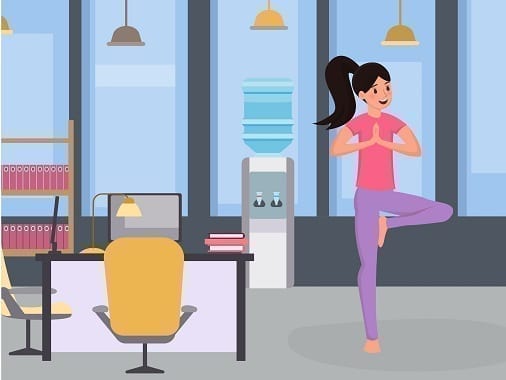Not being able to focus at work is one of the significant issues professionals and office workers deal with. With every passing day, office goers complain of not being able to concentrate. This leads to a dramatic decrease in productivity and efficiency, causing loss of the company and the individual. Some of the most common factors that affect your concentration at work are lifestyle-related. These can be gotten rid of with a bit of will power and determination. But such lifestyle changes are not as easy as they sound and sometimes can demand a lot from people to change them up. However, one of the most effective ways to achieve these changes is to include Yoga asanas for concentration in your daily routine.
4 Important Factors That Affect Concentration At Work
1. Lack of sleep

Inconsistent sleep patterns and lack of enough sleep can mess up your body chemistry and biological systems. Without complete rest, the body is not able to recover from all the stress and burden. Nor can it repair any damage to the various bodily systems. This, in turn, can lead to further breakdown and many dangerous conditions than just lack of concentration.
2. Stress

Stress is one of the main reasons why people often report a lack of concentration. Stress leads to your mind being preoccupied with an issue which you can’t do much about, which then seeps into your daily work and life and disrupts your balance. It makes you emotionally vulnerable and unable to work to your highest possible efficiency. In such a state, Yoga for concentration goes a long way in curbing symptoms of stress.
3. Fatigue

Overworking your mind and body can lead to fatigue wherein your body and mind are both exhausted beyond their limit. They simply refuse to function at anywhere near an acceptable range. A fatigued body will only get worse with time if not given proper care and attention.
4. Insomnia

While lack of sleep due to abnormal sleeping habits can cause a lot of issues, insomnia in itself can be pretty devastating for your body. It happens as you are not able to take rest even if you are trying your best to. This causes lethargy and a significant loss of energy during day time. With this comes an unstable emotional state, thus causing a lack of concentration towards your work. However, Yoga to increase concentration has the capability of dealing with this issue as well.
How Can Yoga Help In Improving Concentration?
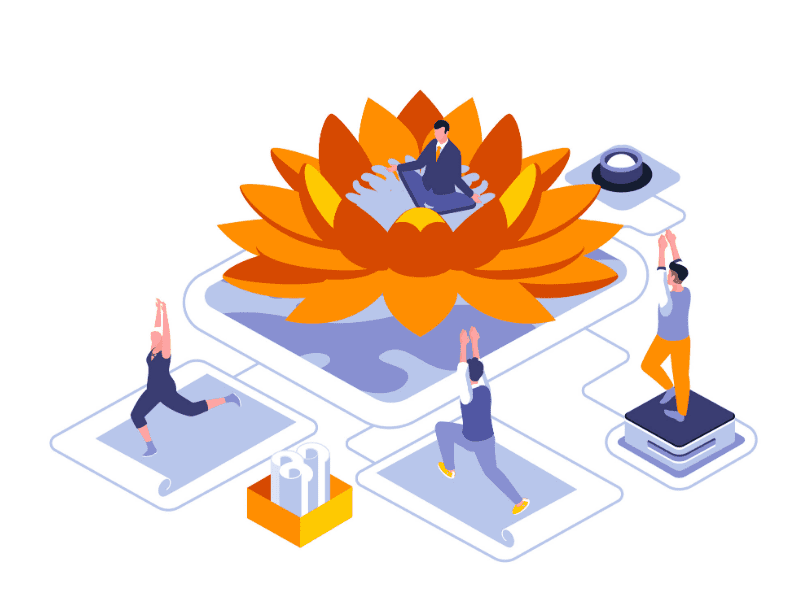
Yoga to increase concentration is a centuries-old exercise technique that focuses on keeping the mind sharp and the body healthy and flexible. In the modern age, the practice of Yoga has seen a resurgence with it being accepted all over the world as the primary way of shaping your mind and body. What used to be a part of ancient Hindu culture and heritage, has today become a widely accepted method of curing almost all modern-day ailments and living a fulfilled life. We have discussed the various uses of Yoga below if you still are in doubt:
- The practice of Yoga for concentration helps your mind to remain calm, helps with concentration, and purges you of all unnecessary thought and keeps your bodily functions in check and, in turn, keeps you healthy.
- Chronicled by the Maharshi Patanjali, Yoga is said to contain the solution for every bodily ailment that can plague a man, and regular practice of Yoga can keep your body free of all ailments and healthy.
- Yoga for concentration clears out the clutter in your mind, returns peace and serenity, and helps your mind to focus. It clears out all the garbage that has accumulated, fixes your stress, insomnia, cures fatigue and tiredness, and helps in healthy recovery of your body.
- Simultaneously, it also allows you to function at the best of your capabilities. Yoga has been scientifically proven to improve brain waves and brain functioning, which means regular Yoga practice will result in your mind getting sharper and sharper.
- Dharana Yoga is a sure-shot way of curing sleeplessness, anxiety, stress, fatigue, and restores body functions to normal, thus paving the way for your body to recover from all the stress and also boosts recovery of your body and mind.
7 Must Try Yoga Exercises To Improve Concentration At Work
1. Tadasana (Mountain Pose)
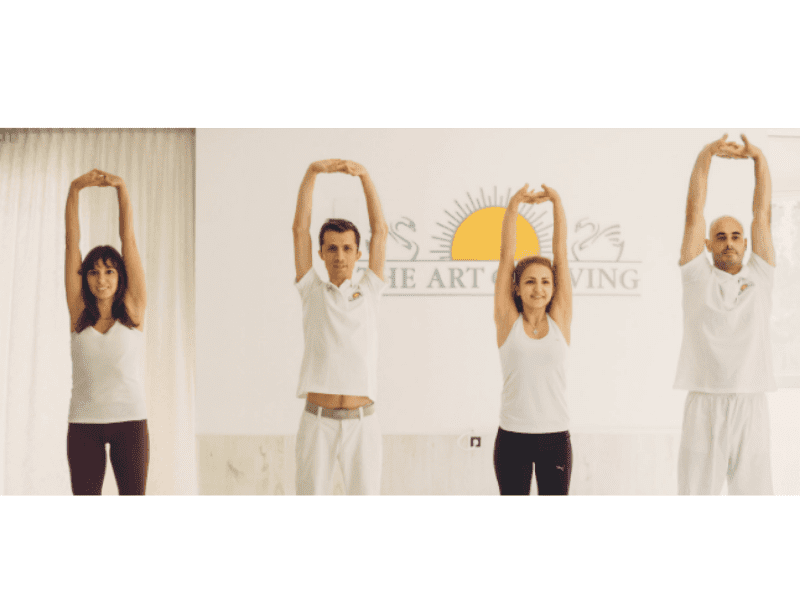
This asana is the foundation of every yoga asana and allows you to build a steady foundation for your practice day in day out. To practice this , your stomach must be empty or should be done at least 2-3 hours after your meal. The asana improves your posture, breathing and enhances the flexibility of your spine and releases all the built-up stress and tension. It is considered one of the best asanas for improving concentration.
Steps :
- Keep some distance between your feet and stand straight.
- Keep your hands hanging parallel to your body.
- Take a deep breath, raise both of your arms upwards and interlock your fingers.
- Next, stand on your toes, raising your heels. By this time you should be feeling the stretch in your body, starting from your toes, right to the fingers.
- Hold your breath in this position for 10 seconds.
- Now exhale and come back to your original pose.
- Repeat this 10 times.
2. Vrikshasana (Tree Pose)
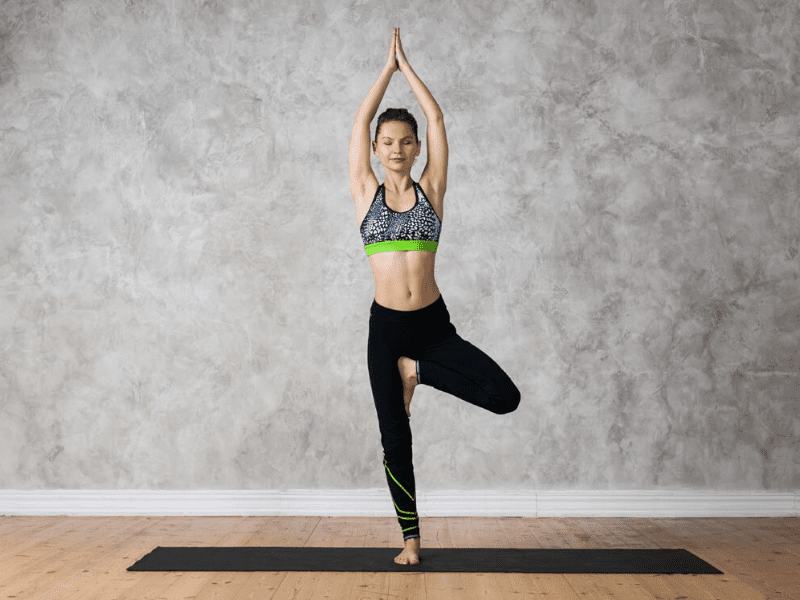
This asana improves your balance and builds strength in your legs and abdomen, making your body and posture much more stable. The asana must be done on an empty stomach and is classified as a beginner level Hath asana.
Steps:
- Stand with your feet two inches apart.
- Look straight ahead and focus on one single point.
- Exhale and bend the right leg, placing the foot on the inside of the left thigh. Make sure that your heel touches the perineum.
- Inhale and raise your arms up, joining them in a Namaste.
- In this position, breath deep and with every exhalation, remember to pull in your tummy muscle and extend your spine upwards.
- Hold this position as long as you can focusing on that single point
- Then slowly exhale and bring your arms down. Then bring your right foot down to the ground.
- Repeat with the other foot.
3. Garudasana (Eagle Pose)
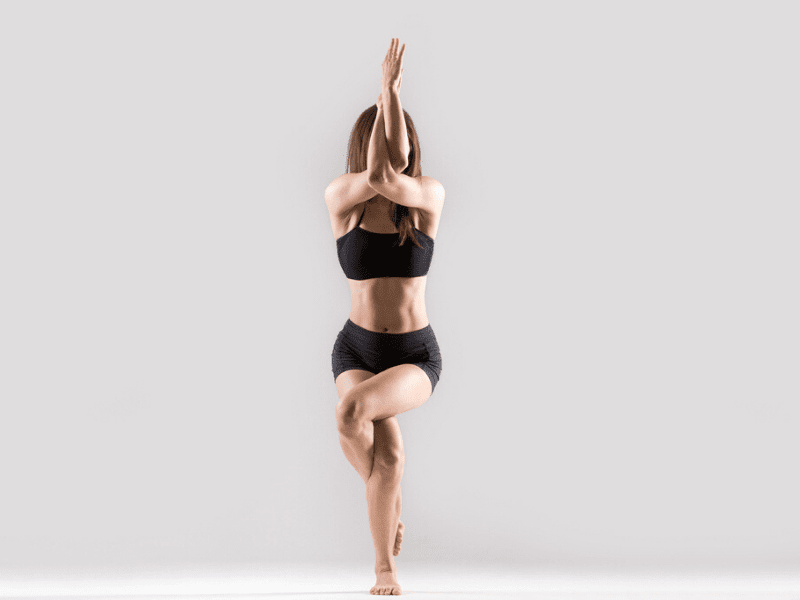
It is practised in the morning on an empty stomach for 10-30 seconds. This asana fixes postural imperfections and releases the stress built up in your joints. Adds balance and stability to your body and makes it much more flexible.
Steps:
- Stand straight like the initial posture of Tadasana.
- Bend your right knee a little and try to wrap the left leg around your right leg in such a way that the knees are stacked on top of each other. The left foot should touch the right leg in the shin.
- Next, raise your arms to the height of your shoulder and wrap your right hand around your left hand. You have to make sure that the elbows are bent at 90 degrees and are also stacked properly, just like the legs.
- Focus and try to strike balance in this particular pose. Remember to move towards the midline rather than leaning on one side.
- Hold the position for 10 seconds and keep on with the deep breathing.
- Release the position and repeat with the opposite limbs.
4. Natarajasana (Dancer Pose)
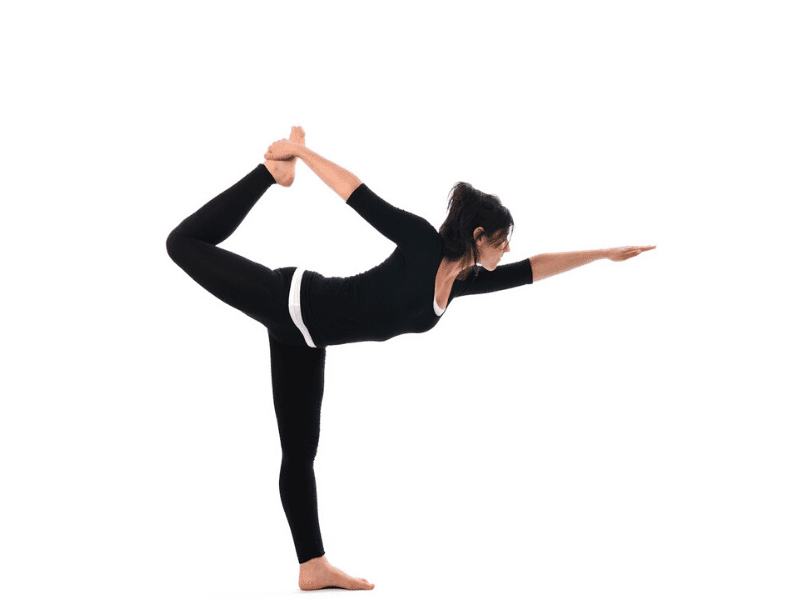
Named after one of the dancing poses of Shiva (Nataraj), this asana is great for reducing weight and significantly improves your digestion and increases metabolism. The asana works on strengthening your chest, thighs, ankles, and greatly improves body flexibility. The asana clears your mind of all thought, clears out stress, improves blood circulation, and is very beneficial for the spine. It is also one of the best asanas for improving concentration.
Steps:
- Stand in the initial step of the mountain pose, breathing normally. Focus your gaze at one point.
- Bend your right knee to raise your leg backwards and hold the right big toe with your right hand.
- Remember to maintain your body weight on the left leg.
- Next, try to raise your leg backwards as far as possible.
- While you do this, remember to rotate your elbow in such a way that right should point upwards.
- Keep raising your feet until it reaches towards the back of your head.
- Now raise your left arm to the front, keeping it straight and your palm facing downwards.
- Strike balance in this pose, focusing on one single point in the front and breath normally.
- Hold this pose for about 20 seconds to a minute.
- Repeat with opposite limbs.
5. Bakasana (Crane Pose)
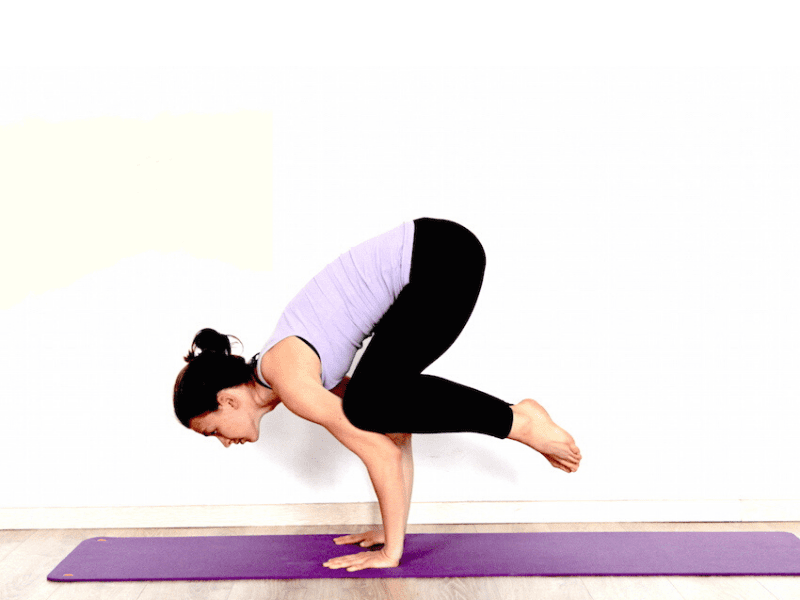
The Bakasana is one of the more challenging asanas and is focused on increasing the strength of your forearms. The asana tones your abdominal muscles and improves mind-body coordination. It releases tension, develops awareness of the body, enhances spine flexibility, and reduces acidity from the body.
Steps:
- Start with the squatting position with your knees stretched apart, arms towards the inner sides of the legs.
- Stretch your fingers wide and place your palms on the floor in front of you maintaining shoulder-width distance. Keep your fingers pointed forwards, bend your elbows slightly.
- Lean a little forward, bringing your knees as close to the armpits as possible.
- Transfer your body weight to your arms entirely still keeping your feet on the floor
- Gently pressing your knees by the side of your arms, try to slowly lift your big toes off the floor.
- Raise your buttocks slightly and rest the entire weight of the body on your arms.
- Lengthen your neck and lift your head. Look straight, focusing your gaze at one fixed point.
- Strike balance and start moving your feet closer so that the inner edges of the feet come together.
- Continue breathing normally and hold.
- Come back to the normal position by lowering your feet and relax.
6. Ustrasana (Camel Pose)
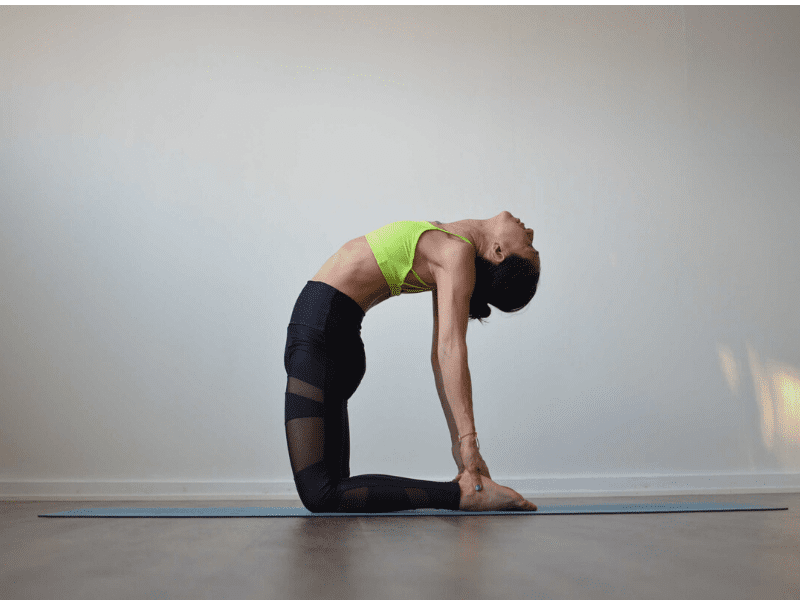
This asana is focused on spine flexibility and relaxation. It strengthens your back and shoulders, improves posture, and is of great help for people suffering from back pain, both chronic and acute. It further improves digestion, excretion, and respiration while stimulating the endocrine glands at the same time.
Steps:
- Stand on your knees, keeping your thighs straight.
- Try to keep the knees and the feet together.
- Without straining your body, lean backwards, bending your body so that you can touch your right heel with your right hand and left heel with your left hand.
- Push the hips towards the front and the thighs should be aligned vertically.
- Next bend your back and head as backwards as possible, still avoiding any strain on your body.
- Relax the muscles of your back and your entire body.
- Rest the weight of the body equally on both the arms and hold the position for as long as is comfortable for you.
- Come back to the initial position by releasing your hands one by one and relax.
7. Paschimottanasana (Seated Backward Bend)
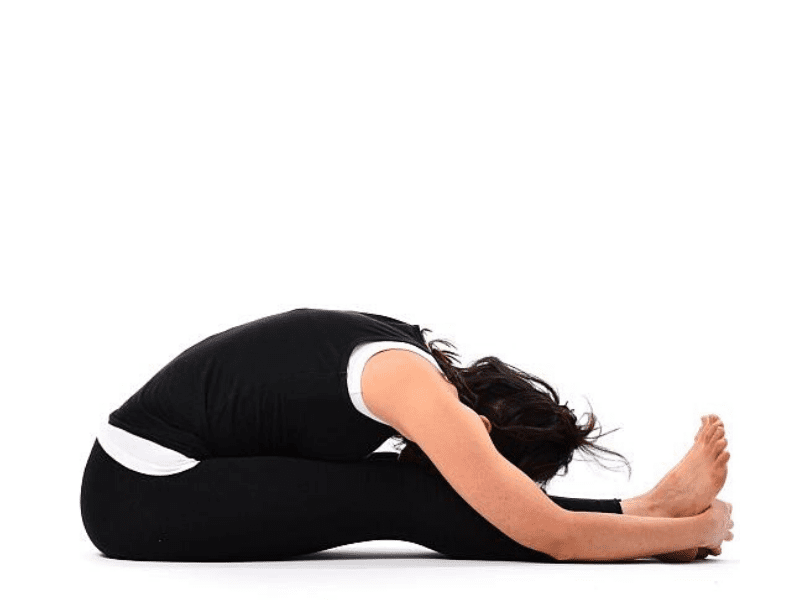
It is another tough asana that greatly improves body flexibility, spine flexibility, releases body stress. The focus of the asana is to release all the pent up stress in the body and removes anger and frustration, providing your mind serenity. It helps in digestion and cures stomach ache, piles, and energises your whole body.
Steps:
- Sit straight up with your legs stretched straight in front of you
- Your spine should be erect and your toes flexed towards you.
- Breath in slowly, raising both your arms above your head and stretch upwards.
- Slowly breathe out, bend forward from your hips and your chin should move towards your toes, with your spine straight.
- Next, place your hands on your legs, wherever you may reach, without straining your body much.
- You may try to hold on to your toes and use them to pull your body forward.
- Hold this position for as long as possible.
- Come back to your original position by bringing your arms again, while inhaling.
- Exhale and bring your arms down, with your palms facing the ground.
Things To Keep In Mind While Practicing Yoga For Concentration
Dharana Yoga is a powerful tool for curing your mind and body. It releases stress, fixes body posture, clears the mind, and strengthens your body. But before you do these asanas, keep in mind that these are supposed to be done on an empty stomach. Some are to be done in the morning before breakfast. Others can be done anytime, but only a few hours after you have had your meal. In a nutshell, Yoga will greatly help your body, organs, joints, and mind and revitalise you from your very core.

